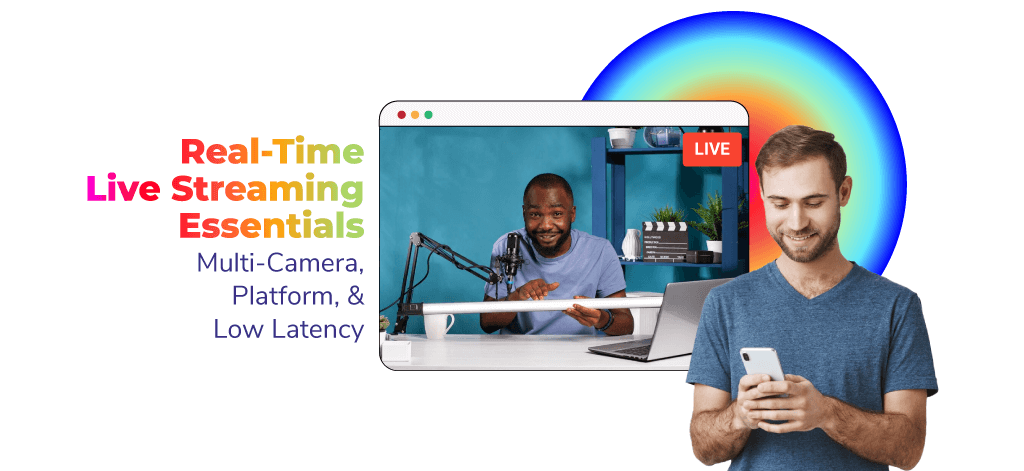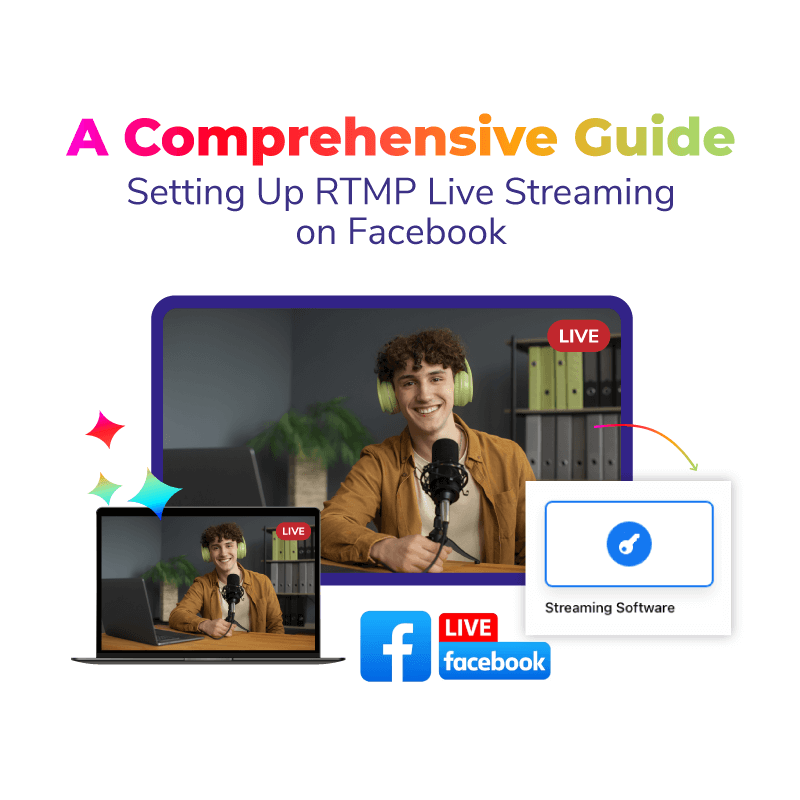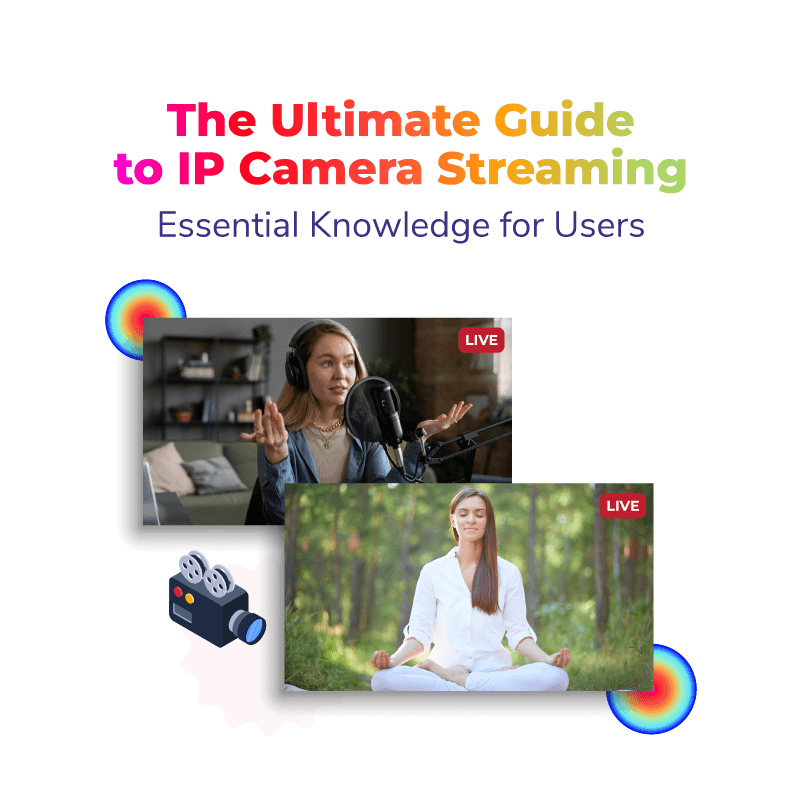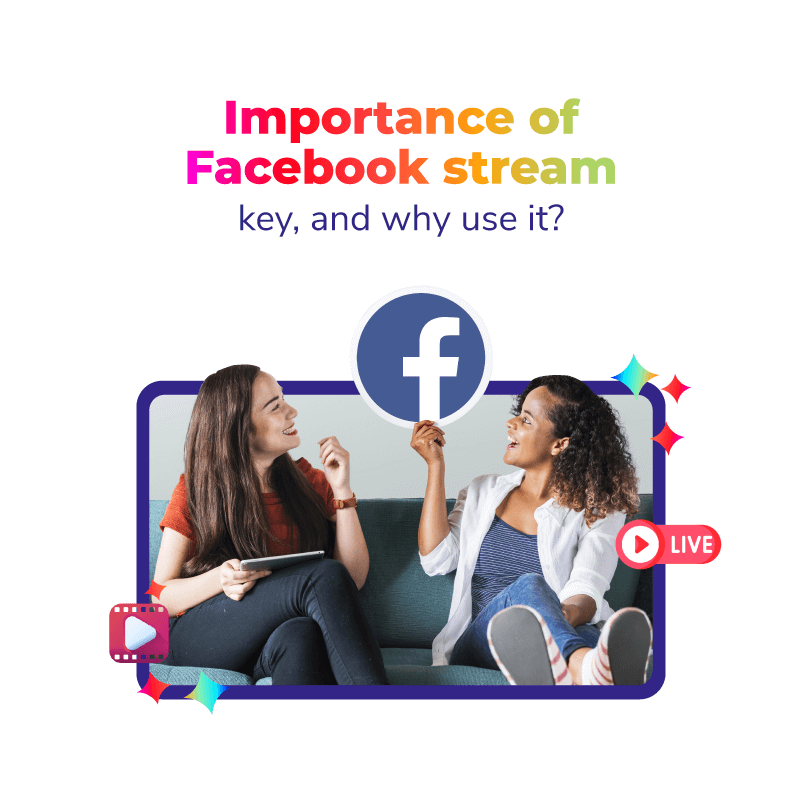In a diversified global era where communication channels and platforms are numerous. However, with technology advancements, the audience demands for immersive and real-time experiences. In the current digital connectivity era, a term has risen to prominence that needs to be discussed—Real-Time Live Streaming. There are many questions that you might put up like what it entails or why it is important. Here in this blog, we are going to explore the various aspects, significance, and applications of real-time live streaming. Furthermore, we will touch on the key pointers of low latency in live streaming, multi-camera streaming as well as multi-platform streaming. So, without further ado, let’s get started;
What is Real-Time Live Streaming?
Real-time live streaming refers to the transformative method of transmitting audio and video content over the internet in real time. In general, this technology is quite similar to what live streaming is but for it, there is less setup needed. Like for example; opening your Instagram, going live and connecting with your followers. This example perfectly shows what this technology means in the current scenario. This approach lets the content creators share live experiences, engage with audiences instantaneously, and foster global connectivity. Furthermore, this type of streaming breaks geographical barriers and offers an interactive experience. Unlike traditional broadcasting, it also has many applications and in the modern day, it’s reshaping communication and content consumption among people.
Diverse Applications of Real-Time Live Streaming: From Gaming to Corporate Events
There are an array of applications for real-time online streaming that cater to various fields of operations. Let’s explore all those;
Entertainment Industry
- Live concerts, music festivals, and performances.
- Streaming of movies, TV shows, and series premieres.
Gaming Community
- Live broadcasting of gameplay on platforms like Twitch and YouTube.
- Esports tournaments and competitive gaming events.
Business and Corporate Events
- Webinars, virtual conferences, and town hall meetings.
- Product launches, AGM, investors meet, and others.
Education Sector
- Workshops, conferences, live lectures, and interactive Q&A sessions.
- Virtual classrooms and distance learning programs.
Healthcare Services
- Remote medical consultations and telemedicine.
- Live surgeries for educational purposes.
Social Media Engagement
- Real-time interactions on platforms like Instagram, Facebook, and Twitter.
- You can showcase or host virtual events, interviews, and behind-the-scenes glimpses respectively.
News and Journalism
- Live reporting from the field during breaking news.
- Interviews, panel discussions, commentary, and others.
Personal Branding and Influencers
- Daily vlogs, lifestyle updates, and personal reflections.
- Collaborations and live interactions with followers.
Crisis Management and Emergency Response
- Real-time updates during emergencies or natural disasters.
- Coordination and communication in crises.
In the dynamic world, one technology advancement can be used in other fields. Similar to that context, real-time online streaming with a multi-camera setup and low latency are two of those that we are going to discuss further.
What is Real-Time Live Streaming with Multi-Camera Setup?
Real-time live-streaming with a multi-camera setup is the latest industry approach to streaming live content over the internet. This approach needs a multiple-camera setup with OBS studio that combines all the footage and showcases the combined feed. For example, it is quite popular in sports broadcasting. In a cricket match, you can encounter that there are multi-camera setups, and on television, you are watching one stream. However, in between, the camera feed changes showcasing different angles, perspectives, or focal points simultaneously.
The primary goal is to deliver a dynamic and engaging viewing experience for the audience. Also, allowing audiences to switch between camera feeds during the live stream. This multi-camera setup adds depth, diversity, and a more immersive feel to the content, whether it’s a live event, webinar, concert, or any other form of online broadcasting. This way the host can offer visual richness as well as improve their storytelling.
Now again, it seems like we are at square one. As we don’t know what real-time low-latency streaming is. But worry not as we are going to talk about it.
Real-Time Low-Latency Streaming: Instant Connectivity
Real-time low-latency Streaming stands at the forefront of the digital revolution, delivering instantaneous connectivity between content creators and their audiences. This innovative streaming approach minimizes the delay between content creation and its delivery, ensuring a swift and responsive viewer experience.
Its usefulness lies in providing seamless, real-time interaction, particularly crucial for live events, gaming, and interactive broadcasts. The trending nature of this technology is driven by the growing demand for immediacy in online experiences, reflecting a desire for live content without noticeable delays.
Significantly, when integrated with Multi-Camera Streaming and Real-Time Live Streaming, Low-Latency Streaming elevates the overall viewer engagement. This fusion creates a dynamic and immersive viewing atmosphere, where audiences can effortlessly switch between camera angles, fostering an interactive and personalized live streaming experience.
Now, coming to the last aspect which is multi-platform real time live streaming.
Multi-Platform Real-Time Live Streaming: Reaching To The Globe
Multi-platform real-time live streaming is an approach that transcends boundaries, with its solutions that let hosts connect with global audiences in an instant. This is an innovative approach that comes into place when multiple social media platforms have their fair share of the audience. As a brand, business, or influencer, it is highly tough to create different streams to engage them. The multi-platform real-time live streaming is an innovative approach that involves simultaneous broadcasting. This streams the live content across various platforms such as YouTube, Twitch, and Facebook Live in real-time to ensure widespread content. The best of its use is that it broadens the event accessibility, by allowing the audience of diverse platforms to participate.
Furthermore, The integration of low latency across these platforms ensures minimal delays, fostering real-time interaction and enhancing viewer engagement. Some of the best ways to achieve low latency streaming;
- Optimize Encoding: Use H.264/5 with low keyframes for effective video compression and faster encoding, while maintaining the quality of stream.
- CDN Selection: Choose a global CDN for proximity, to reduce server-to-client distance and minimize latency in your next live streaming.
- Segment Duration: By shortening video segment duration in streaming protocols like HLS to 2 seconds, can balance latency and buffering risks.
- WebSockets/RTC: Implement WebSockets or WebRTC for bidirectional, real-time communication, to ensure low-latency streaming performance.
- Chunked Encoding: Transmit smaller video parts using chunked transfer encoding, enabling more real-time delivery and reducing overall latency.
Summing Up
Undoubtedly, real-time live streaming is an essential approach in the current modern dynamics due to its diverse applications. Besides that to give an immersive experience to the audience with interactive and engagement key factors, multi-camera and simultaneous live streaming need to be accounted for. Any event that any business hosting and thinking of showcasing over the internet needs to rethink its decision. Why? Because streaming with in-house equipment cannot help you achieve the professional level of streaming.
So, what to do about that? Just nothing. At Dreamcast, we can help you with 360-degree, multi-camera, and simultaneous streaming too to ensure your event content reaches globally. If you want to learn more about it, Book Your Free Demo and get all your queries answered.
Connect with the Industry's Most Experienced
Live Streaming Service Providers.
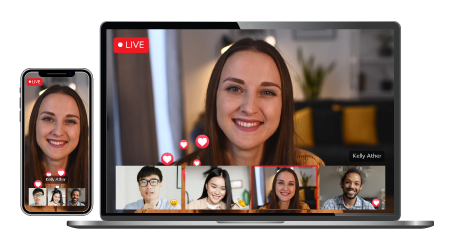
FAQs
To achieve a seamless real-time live streaming experience typically it requires a minimum upload speed of 5 Mbps. However, factors such as video resolution and bitrate may affect this recommendation.
Yes, free streaming platforms exist, but they may lack the advanced features necessary for professional multi-camera setups. Consider dedicated streaming services for a more robust and tailored experience.
To reduce latency, you need to select a platform with low-latency options, optimize encoding settings, and leverage content delivery networks (CDNs). Regular testing and adjustment are key to minimizing latency.
Yes, streaming copyrighted content without proper authorization is illegal. Make sure you have the grade-appropriate rights or licenses to avoid legal complications when streaming content.
The best practice to secure your live-streaming event is by utilizing encrypted streaming options. Also, implementing advanced authentication measures, and systematically updating software and security protocols. In addition, restrict access to authorized viewers for enhanced security.
Connect with the Industry's Most Experienced
Live Streaming Service Providers.














